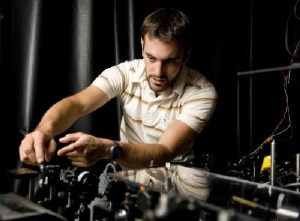Nov 21 2008
The promise of quantum computing is that it will dramatically outshine traditional computers in tackling certain key problems: searching large databases, factoring large numbers, creating uncrackable codes and simulating the atomic structure of materials.
 Stanford researcher David Press in the lab. Credit: Linda Cicero -- Stanford News Service
Stanford researcher David Press in the lab. Credit: Linda Cicero -- Stanford News Service
A quantum step in that direction, if you'll pardon the pun, has been taken by Stanford researchers who announced their success in a paper published in the journal Nature. Working in the Ginzton Laboratory, they've employed ultrafast lasers to set a new speed record for the time it takes to rotate the spin of an individual electron and confirm the spin's new position.
Why does that matter? Existing computers, from laptops to supercomputers, see data as bits of information. Each bit can be either a zero or a one. But a quantum bit can be both zero and one at the same time, a situation known as a superposition state. This allows quantum computers to act like a massively parallel computer in some circumstances, solving problems that are almost impossible for classic computers to handle.
Quantum computing can be accomplished using a property of electrons known as "spin." A single unit of quantum information is the qubit, and can be constructed from a single electron spin, which in this experiment was confined within a nano-sized semiconductor known as a quantum dot.
An electron spin may be described as up or down (a variation of the usual zero and one) and may be manipulated from one state to another. The faster these electrons can be switched, the more quickly numbers can be crunched in a quantum fashion, with its intrinsic advantages over traditional computing designs.
The qubit in the Stanford experiment was manipulated and measured about 100 times faster than with previous techniques, said one of the researchers, David Press, a graduate student in applied physics.
The experiments were conducted at a temperature of almost absolute zero, inside a strong magnetic field produced by a superconducting magnet. The researchers first hit the qubit with laser light of specific frequencies to define and measure the electron spin, all within a few nanoseconds. Then they rotated the spin with polarized light pulses in a few tens of picoseconds (a picosecond is one trillionth of a second). Finally, the spin state was read out with yet another optical pulse.
Similar experiments have been done before, but with radio-frequency pulses, which are slower than laser-light pulses. "The optics were quite tricky," Press said. The researchers had to find a single, specific photon emitted from the qubit in order confirm the spin state of the electron. That photon, however, was clouded in a sea of scattered photons from the lasers themselves.
"The big benefit is to make quantum computing faster," Press said. The experiment "pushed quantum dots up to speed with other qubit candidate systems to ultimately build a quantum computer."
Quantum computers are still years away. In the shorter term, Press said, researchers would like to build a system of tens or hundreds of qubits to simulate the operation of a larger quantum system.
The other authors of the Nature paper were Bingyang Zhang of the Ginzton Lab, and Thaddeus Ladd and Yoshihisa Yamamoto of the Ginzton Lab and the National Institute of Informatics in Tokyo.